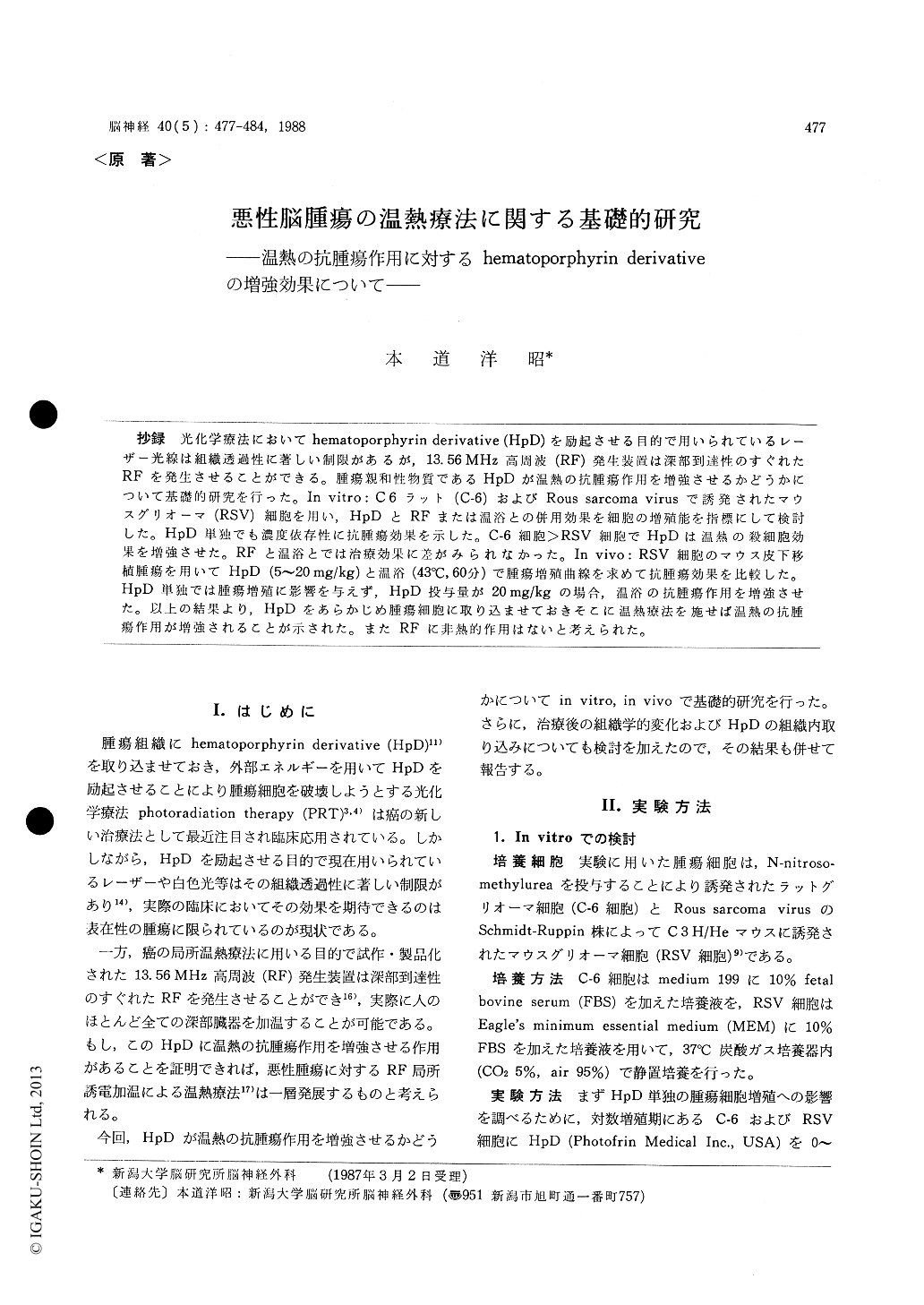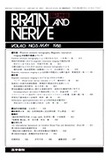Japanese
English
- 有料閲覧
- Abstract 文献概要
- 1ページ目 Look Inside
抄録 光化学療法においてhematoporphyrin derivative (HpD)を励起させる目的で用いられているレーザー光線は組織透過性に著しい制限があるが,13.56MHz高周波(RF)発生装置は深部到達性のすぐれたRFを発生させることができる。腫瘍親和性物質であるHpDが温熱の抗腫瘍作用を増強させるかどうかについて基礎的研究を行った。In vitro:C6ラット(C−6)およびRous sarcoma virusで誘発されたマウスグリオーマ(RSV)細胞を用い,HpDとRFまたは温浴との併用効果を細胞の増殖能を指標にして検討した。HpD単独でも濃度依存性に抗腫瘍効果を示した。C−6細胞>RSV細胞でHpDは温熱の殺細胞効果を増強させた。RFと温浴とでは治療効果に差がみられなかった。In vivo:RSV細胞のマウス皮下移植腫瘍を用いてHpD (5〜20mg/kg)と温浴(43℃,60分)で腫瘍増殖曲線を求めて抗腫瘍効果を比較した。HpD単独では腫瘍増殖に影響を与えず,HpD投与量が20mg/kgの場合,温浴の抗腫瘍作用を増強させた。以上の結果より,HpDをあらかじめ腫瘍細胞に取り込ませておきそこに温熱療法を施せば温熱の抗腫瘍作用が増強されることが示された。またRFに非熱的作用はないと考えられた。
Photoradiation therapy using the photosensiti-zing agent, hematoporphyrin derivative (HpD), and laser light has been currently employed as a new modality for the treatment of cancer. At present, however, the application of this therapy is limited to superficial tumors because of diffi-culties in achieving light penetration, whereas 13.56 MHz radiofrequency (RF) used in hyperther-mia is capable to penetrate into deeper regions and elevate the temperature of brain tumors.
In the present studies, the author evaluated an anti-tumor effect of hyperthermic treatment with HpD administration on experimental malignant brain tumors both in vitro and in vivo and, moreover, investigated the histological changes of subcutaneous tumors following water bath heating and the uptake of HpD into the brain and subcutaneous tumors.
In vitro, C-6 and Rous sarcoma virus-induced mouse glioma cells (RSV glioma cells) were incubated in the medium containing HpD (0-125 μg/ml) for 24 hours. Hyperthermia was performed either in a water bath or by 13.56 MHz RF heating in the range of 37-43℃. All procedures were carried out in the dark. The anti-tumor effect was evaluated by counting the viable glioma cells. HpD itself showed a growth inhibitory effect on C-6 and RSV glioma cells dose-dependently, while synergistic effect was observed in combina-tion with hyperthermia. C-6 cells were more sensitive to this treatment than RSV glioma cells. The degree of response depended on the heating time and the temperature. In both cells, the effect of heating by water bath and 13.56 MHz RF was similar at each temperature.
In vivo, the tumor model was a RSV glioma transplanted in C 3 H/He mice. The subcutaneous tumor was used for treatment 12 to 14 days after inoculation of single suspension of 2 to 3×105 RSV glioma cells. Treatments were as follows : controls (no treatment) ; HpD alone (5, 10, 20 mg/kg i. p.) ; water bath heating only (for 60 min at 43℃) ; HpD plus water bath heating (48 hr after admin-istration of HpD). The anti-tumor effect was evaluated on the basis of the growth curve of the tumors. HpD (5, 10, 20 mg/kg i. p.) alone did not alter the tumor growth. At a dose of 20 mg/kg, HpD plus water bath heating showed a greater anti-tumor effect than water bath heating only.
The subcutaneous tumors were removed at varying periods after water bath heating (for 60 min at 43℃), and fixed in 10% formalin, then sectioned and stained with hematoxylin-eosin. Immediately after water bath heating, the dilata-tion and congestion of tumor vessels and minute hemorrhages occurred. Three days later, degene-ration of the tumor cells appeared in the center of the tumor and residual tumor cells were seen around the tumor. These residual tumor cells started to regrow within 7 days after treatment.
The uptake and distribution of HpD was assess-ed by fluorescence microscopy. Compared to the surrounding normal brain and muscle, there was a significant preferential uptake of HpD into the brain and subcutaneous tumors. However, the intratumoral distribution of HpD was hetero-geneous.
These data suggest that hyperthermia plus HpD may become one of the major therapeutic moda-lities for the treatment of human gliomas.

Copyright © 1988, Igaku-Shoin Ltd. All rights reserved.


